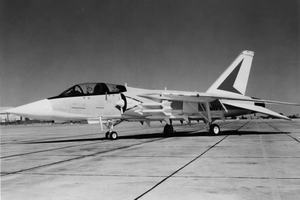Mekaniq Mi-9.C Fatalwe: Difference between revisions
Arthurista (talk | contribs) No edit summary |
Arthurista (talk | contribs) mNo edit summary |
||
| Line 26: | Line 26: | ||
|} | |} | ||
The Mekaniq Mi-9.C Fatalwe is a [[Sante Reze|Rezese]] model of twin-engine, variable-geometry heavy tactical fighter. The Fatalwe was designed as a long range interceptor and air-superiority fighter, although later upgrades have enabled it to act in the strike role. | The '''Mekaniq Mi-9.C Fatalwe''' is a [[Sante Reze|Rezese]] model of twin-engine, variable-geometry heavy tactical fighter. The Fatalwe was designed as a long range interceptor and air-superiority fighter, although later upgrades have enabled it to act in the strike role. | ||
At the time of its introduction, it was one of only four heavy fighters in the world optimised for the air dominance role, alongside the [[Tsurushima]]n {{wp|F-15 Eagle|Kai-79}}, [[Belfras]]ian [[Aigios Viper]] and the [[Arthuristan Dynamics/Ahuriri Aerospace Cyclone]] jointly developed by [[Arthurista]] and [[Onekawa-Nukanoa]] on the basis of the Viper. It remains highly competitive today through the application of periodic upgrade packages. The latest Mi-9C7 upgrade program, implemented between 2015-2020, introduced the REA-7 {{wp|Active electronically scanned array|AESA radar}}, pod-mounted {{wp|Infrared search and track|IRST}}, as well as an improved self-defence electronic countermeasures suite. | At the time of its introduction, it was one of only four heavy fighters in the world optimised for the air dominance role, alongside the [[Tsurushima]]n {{wp|F-15 Eagle|Kai-79}}, [[Belfras]]ian [[Aigios Viper]] and the [[Arthuristan Dynamics/Ahuriri Aerospace Cyclone]] jointly developed by [[Arthurista]] and [[Onekawa-Nukanoa]] on the basis of the Viper. It remains highly competitive today through the application of periodic upgrade packages. The latest Mi-9C7 upgrade program, implemented between 2015-2020, introduced the REA-7 {{wp|Active electronically scanned array|AESA radar}}, pod-mounted {{wp|Infrared search and track|IRST}}, as well as an improved self-defence electronic countermeasures suite. | ||
Revision as of 21:10, 17 November 2022
This article is incomplete because it is pending further input from participants, or it is a work-in-progress by one author. Please comment on this article's talk page to share your input, comments and questions. Note: To contribute to this article, you may need to seek help from the author(s) of this page. |
| Mi-9.C Fatalwe | |
|---|---|

| |
| Role | Air superiority |
| National origin | Sante Reze |
| Manufacturer | Mekaniq |
| First flight | 1972 |
| Introduction | 1978 |
| Status | In service |
The Mekaniq Mi-9.C Fatalwe is a Rezese model of twin-engine, variable-geometry heavy tactical fighter. The Fatalwe was designed as a long range interceptor and air-superiority fighter, although later upgrades have enabled it to act in the strike role.
At the time of its introduction, it was one of only four heavy fighters in the world optimised for the air dominance role, alongside the Tsurushiman Kai-79, Belfrasian Aigios Viper and the Arthuristan Dynamics/Ahuriri Aerospace Cyclone jointly developed by Arthurista and Onekawa-Nukanoa on the basis of the Viper. It remains highly competitive today through the application of periodic upgrade packages. The latest Mi-9C7 upgrade program, implemented between 2015-2020, introduced the REA-7 AESA radar, pod-mounted IRST, as well as an improved self-defence electronic countermeasures suite.
Specifications (Mi-9.C7)
- Crew: 2
- Engines: 2 x afterburning turbofan engines, each developing 75kn dry and 125kn with afterburner
- Wingspan: 10.46 (retracted)
- Length: 20.9m
- Height: 4.55m
- Empty Weight: 19,825kg
- Top speed: Mach 2.33 at high altitude
- Ceiling: 17,000m
- Range: 3,000km
- Combat radius: 1,500km+ with drop tanks
- Armaments: 1 × 20mm gatling cannon (680 rounds), 8,500kg of munitions on ten hardpoints.